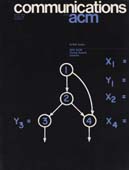March 1976 - Vol. 19 No. 3

Features
Computer science as empirical inquiry: symbols and search
Computer science is the study of the phenomena surrounding computers. The founders of this society understood this very well when they called themselves the Association for Computing Machinery. The machine—not just the hardware, but the programmed, living machine—is the organism we study.
Joining policies in a multipriority multiclass batch computer system
Consider a multipriority batch computer system which users from several different classes may join, with toll, service, and waiting charges. Such a system is formulated here as a semi-Markov decision process, in which the aim of arriving users is to minimize their expected loss. The optimal joining policy of arriving users who may join the system at some of its queues is a control limit policy, with a single control number for any possible queue and the user's class; a newly arriving user will join a queue that is not filled up to the control number corresponding to this queue and the user's class. In this paper control numbers, as well as lower and upper bounds for the control numbers and the capacities of the system's queues, are derived.
A program data flow analysis procedure
The global data relationships in a program can be exposed and codified by the static analysis methods described in this paper. A procedure is given which determines all the definitions which can possibly “reach” each node of the control flow graph of the program and all the definitions that are “live” on each edge of the graph. The procedure uses an “interval” ordered edge listing data structure and handles reducible and irreducible graphs indistinguishably.
Intentional resolution of privacy protection in database systems
Traditionally, privacy protection in database systems is understood to be the control over what information a given user can get from a database. This paper is concerned with another, independent, dimension of privacy protection, the control over what a user is allowed to do with a piece of information supplied to him by the database. The ability to condition the supply of information on its intended use is called here “intentional resolution” of privacy protection.
The practical importance of intentional resolution is demonstrated by several examples, and its realization is discussed. It is shown that intentional resolution can be achieved, but that it involves a radical change from the traditional approach to the process of user-database interaction. In particular, it appears to be necessary for the database to impose a certain amount of control over the internal behavior of users' programs which interact with it. A model for user-database interaction which admits such a control is developed.



